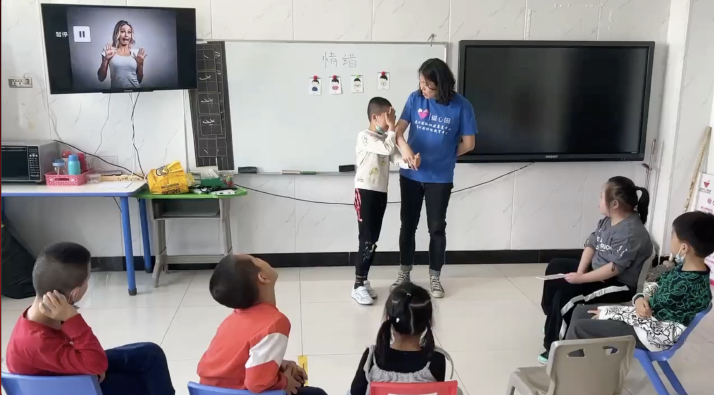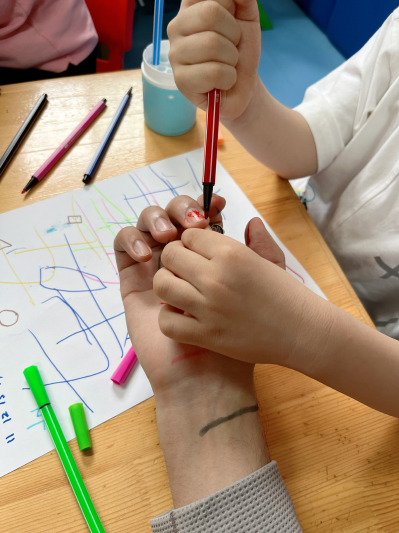| Lifestyle |
| Creative therapies promote children's growth | |
|
|
 Children participate in a class on expressing emotions at Urumqi Love Garden, in Urumqi, Xinjiang Uygur Autonomous Region in May 2022 (COURTESY PHOTO)
Imagine a child who does not want to eat dumplings, despite being told by his grandfather to do so. Confused, the child picks up the bowl and stares at it for over an hour, not eating but also refusing to put it down. "That is what has happened one day in Urumqi Love Garden (ULG) [in Xinjiang]," Lyu Xiaoning, the founder of Viva la Vida (VIVA), a global platform for people to share stories through art, told Beijing Review. VIVA owns an online art gallery and social networking platform to exhibit portraits of life by different people. "When the staff of ULG took the bowl away from the child, he started crying," Lyu said, adding that the ability to express emotion is simple and ordinary for most people, but can be out of reach for some children, for example, children with autism, Down syndrome or intellectual disabilities. "Behind the countless diagnoses, their education and mental health lack attention," Lyu said. In 2021, VIVA and Beijing Star Power Charity Foundation, a nonprofit organization established by more than 120 Olympic and world champions, jointly developed an art therapy charity fund that focuses on improving children and young people's mental health through the arts and education courses. The ULG, founded in 2004, is the first institution established in northwest China's Xinjiang Uygur Autonomous Region to specifically serve children aged 2-16 with different physical, mental or other developmental needs. It is also a designated rehabilitation institution for autism and other disabilities. "ULG is one of our partners. We hope to find better solutions for children there," Lyu added. According to a 2021 article on the website of the China Philanthropy Research Institute at Beijing Normal University (BNU), there are about 8.17 million disabled children aged 0-14 in China, accounting for 2.67 percent of the total population of children. According to the World Health Organization (WHO), up to 20 percent of children and adolescents worldwide suffer from a debilitating mental disorder. "Disabled children are more likely to also suffer from mental disorders. The data from BNU and the WHO reveal that these children face serious mental health challenges. Without early detection and intervention, these mental disorders are likely to have a lifelong impact," Lyu said. Targeted therapy To better meet the needs of children served by ULG, in 2022, VIVA and ULG jointly established an early childhood education class on social communication. "We try to guide students to understand their feelings, and encourage them to express how they feel and then gradually make connections with their emotions," Daisy Wang, a partner of the therapy fund, told Beijing Review. For example, there is an activity called Smile Challenge, during which students need to try to make someone else in the class laugh, and the person being made to laugh needs to say "thank you for making me laugh" as feedback. When she first tried the activity, one of ULG's teachers, Guo Yuqi, wondered if it would actually be of any help to the students as it only used simple communication methods. "Some children were afraid to take a turn, but after others made them laugh, they became more and more eager to try," Guo said. "Some tried their best to tickle others or touch their faces... Some children would walk directly over to others and say 'smile, you smile'." "During their interactions, I found that they changed others through their own efforts. They have the ability and desire to change. That really inspired me a lot," Guo added. Another activity is called My Positive Self-Talk. Teachers help the children to draw a sunflower and write in each petal a positive sentence, such as "I can get through this," "Today is going to be an awesome day," and "I believe in myself and my ability." Children are encouraged to read these positive statements aloud to themselves. "This helps them build confidence," Wang said. According to Guo, participating in these activities helped the students manage their emotions. "They used to deal with their emotions mainly with their body language. Now, they first stabilize their emotions and express their needs, then take corresponding action," she said. "The children had been reluctant to talk or ask questions about anything, but through these courses, they started to express their feelings and have shown a more stable mindset with less physical conflicts than before," Wang said. "The activities help the children go from being overwhelmed, not paying attention to others, and not being willing to express themselves to gradually having a little bit of a sense of self-awakening."  A child with autism draws on the hand of this Beijing Review reporter at a rehabilitation center in Shenzhen, Guangdong Province in May (TAO XING)
A diversified process "The ULG program is a part of the VIVA life education practice," Lyu said. VIVA also focuses on other groups, such as women and refugees, not only in China, but also in other countries and regions. For example, last August in Berlin, VIVA hosted an art therapy workshop for refugees from Ukraine, Afghanistan, Syria and other countries. The workshop helped these people, who have lost their homes, find healing through artistic creation such as painting and writing. Since it was founded in mid-2018, VIVA has received more than 20,000 paintings from over 60 countries and regions. The paintings reveal how people with different backgrounds and experiences draw their lives. "Recently, we have also tried to introduce art into the therapy by using the paintings we have collected over the past five years," Lyu said. Lyu's team plans to ask students to describe what they see in the paintings as a way to guide them to better express their feelings and deep inner troubles. Based on the results of these discussions, the team will invite artists experienced in working with marginalized communities to deliver workshops aimed at improving mental health. These activities would not be possible without volunteers from many regions. In the past five years, a volunteer community of more than 1,000 people in different countries and regions had been established, according to Lyu. "We are trying to promote the integration and harmony of people with disabilities and non-disabled people," she added. Holding exhibitions is also an important part of raising awareness. "We invite people who participate in our art therapy program, for example, teachers and disabled children from ULG, to draw their lives," Lyu said. VIVA invites professional curators to help exhibit these works and invite the participants to tell their stories. The online and offline painting exhibitions also aim to enhance public understanding of disadvantaged groups. "We hope to attract worldwide attention and help raise funds to support them," Lyu added. (Print Edition Title: Theray Through Art) Copyedited by G.P. Wilson Comments to taoxing@cicgamericas.com |
|
||||||||||||||||||||||||||||
|
